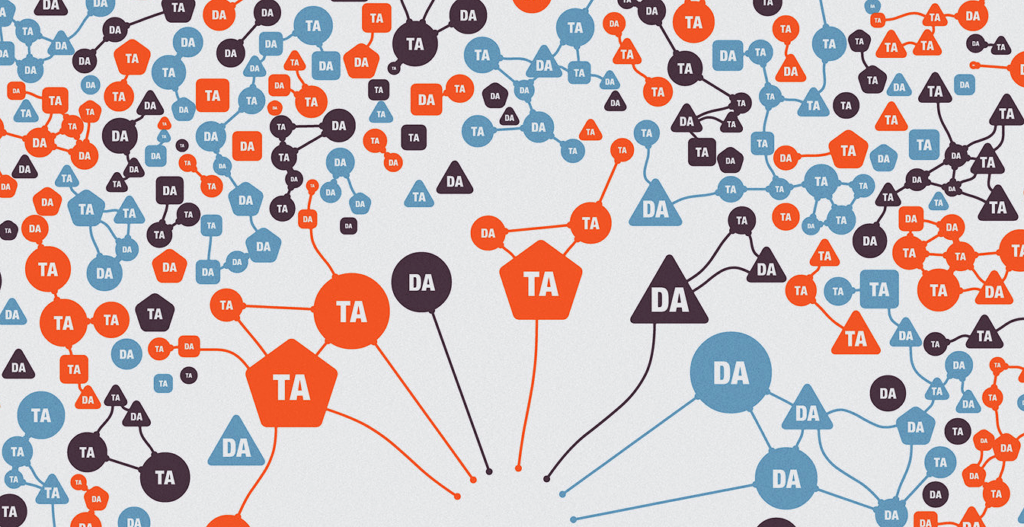It is easy to become pessimistic, if not dystopic, about tracking technologies. The current digital services landscape promotes scoring, selecting and sorting of people for the purposes of maximizing profit. Machine logics rely on profiling characteristics and predicting actions, and management by algorithms appears to be disproportionately affecting those with temporary and low-income jobs. Tracking technologies become complicit in deepening and accelerating social divisions and inequalities. The most vulnerable in societies have no say in how their actions are monitored and lives are harmed by algorithmically produced metrics.
In this context, Quantified Self (QS) – an international community of ‘self-trackers’ that shares insights gained through self-quantification and data analysis – seems rarified, an example of the privileged techno-elite positioned to use tracking data to pursue their own values and goals. With this limitation, QS hardly appears to be a useful prism for understanding the larger societal issues at stake in tracking. Yet I would argue that, as a counterexample, self-trackers are particularly good to think with. The reflective qualities of QS-inspired self-tracking offer important clues to how to have livable relations with metrics and machine logics more generally.
The Means of Knowledge Production
In the past decade QS has served as a rich ethnographic site for exploring the co-evolving of humans and technologies. Metrics offer looking glasses for seeing and knowing social life, suggesting that we need to explore epistemic and methodological potentials opened by them. Studies underline the fact that technologies are not adopted uncritically; people contribute to and transform them. They question how uses of technologies disrupt, or become aligned and resonate with, present and future aims.
The focus on learning at the Quantified Self meetups – exercised rigorously with ‘show-and-tell presentations’ during which self-trackers narrate their experiments in ten-minute time slots, recounting what they did, how they did it, and what they learned – underlines that data and metrics are never an aim in itself. The talks detail how numbers and charts are being used in a curious and open-ended way. One might be counting tears, pages read, or negative thoughts. Self-tracking might reveal aspects of oneself that one was not even looking for.
Self-trackers use metrics for detouring from fixed outcomes, exploring limits and boundaries, and defying norms and rules. They are seizing the means of knowledge production in order to reframe epistemic values and politics. The aim of tracking is to intensify the phenomenon – not only to measure it, but to perceive it more clearly, to examine it and to modify it.
Numbers have a role in performing and transforming life, but they should be engaged with care or they become a burden. QS-related metrics operate within a temporal framework. Self-tracking practices first stimulate and heighten awareness of intentionality and senses, but can then become increasingly limiting in terms of self-experience. The original enthusiasm for the focused attention on a demarcated aspect of the self or the everyday shifts into a more skeptical attitude.
The turn to skepticism or ending of a self-tracking project does not mean that it has failed, or that it does not work; rather, experiencing numbers as only being able to partly describe the totality of the lived life is a crucial aspect of learning. The specific metrics have revealed what they can: it is time to move forward. Voluntary self-tracking allows users and targets of metrics to define how they might be of service. It emphasizes how crucial it is to ask – time and again – whether the use of metrics resonates with everyday aspirations. This kind of definition work stresses the importance of not letting the measurer fade into the background: the algorithmic mechanisms and metrics used need to be made traceable and modifiable to the measured.
Between Technology and Life
Tracing the measurer is precisely what is discouraged by an algorithmic sorting culture that relies on top-down categories and controls with no possibility for people to review and challenge them in the context of their lives as they actually unfold over time.
The call to expose measurers and the measuring logics is not new, but it is increasingly pressing because sorting mechanisms exercise politics hidden within practices that are portrayed as mundane or objective: think of credit scoring, hiring practices, social media engagement, health care diagnostics, or student evaluations. Uncovering the logic of the measurer helps us trace sorting and segmentary powers. Of course, to do this we need to examine how algorithms themselves are designed, but to comprehend what exactly the opportunities and harms of algorithmic systems are, we need an ethnographic approach to understand how people actually live with metrics.
To be sure, most interactions with metrics are counterexamples to the experience self-trackers, and this is telling. We get very different answers when we explore the questions: What is learned with metrics? Who is allowed to do the learning, and with what kind of mandate? How metrics are adopted or refashioned in everyday lives and in organizations? How does the person applying for a loan or receiving a credit score reflect, as the self-tracker does, on whether the measures resonate with their everyday experiences and aspirations? Do they get to qualify, repurpose, or discard metrics when they don’t? Are they able to shift or recontextualize metrics over time?
By understanding situational practices, ethnographers can reach further than merely tracing the work of sorting powers. Metrics operate between technology and life. With their sensitivity to the liminal and in-between, ethnographers are well equipped to grasp both the problems and potentials of metrics. Data analytics and metrics remain highly ambiguous as to what they enable. They can enhance personal autonomy and social cohesion, or seriously violate them.
Ethnographers have a vital role in designing digital systems that do not preclude access to metrics and data analytics but teach how they can be utilized to the benefit of individuals, their communities, and society at large. With a sensitivity to questions of value and related transformations and conversions, ethnographers can uncover the partial and ambivalent ways in which metrics are put to use.
Metrics have a remarkable capacity to contribute to situational objectivity: the calculated information becomes evaluated in relation to personal, social and organizational aims. The same numbers and charts can be interpreted and exercised in very different ways, depending on their social, political and economic value and worth. In the self-tracking context, numbers are engaged with more eagerly when the charts are developing to the desired direction. In contrast, metrics are downplayed and actively ignored if they fail to conform to the intended aims.
Cultivating Metric Awareness
Metrics-aware attitude is at once critical and creative: it is attentive to the transforming effects of metrics in people’s lives. Being aware of metrics translates into a readiness to work against them, to point out their limitations and offer counter-measures on the grounds of negative and unintended consequences. At the same time, however, metrics can be effectively deployed for the purposes of social enquiry. Ethnographers should not shy away from numbers and metrics, but endorse computational tools as an empirical resource. Ethnography can bring into a productive tension what is often treated as opposite: objectifying life with metrics and carefully navigating social worlds. The unstable and partial nature of metrics makes a perfect ally for reflective ethnographic practice.
By foregrounding what matters in terms of metrics, indicating how they open and close options, ethnographers can increase the capacity to resist oppressive and unequal computational practices and assist in developing better alternatives. The current sorting and classifying of the most vulnerable in the society offers a very limited understanding of what metrics are, and what computational tools can do in terms of knowledge production.
In order to demonstrate this, it is of utmost importance to continue the following of the uses of digital data and data analytics; doubt any universal claims about technologized futures; and cultivate the great potential of metrics in terms of creative ethnographic engagement. Having livable relations with algorithmic systems and metrics means that we need to know them as intimately as self-trackers do.
References
Image: “Dada Visualization I” by Mario Klingemann (modified) via Flickr (CC BY-NC 2.0)
Berson, J (2015) Computable Bodies: Instrumented Life and the Human Somatic Niche. London: Bloomsbury
Kristensen, D. B., & Ruckenstein, M. (2018). Co-evolving with self-tracking technologies. New Media & Society, 20(10), 3624-3640.
McCosker, A (2017) Data literacies for the postdemocraphic social media self. First Monday Available at: http://firstmonday.org/ojs/index.php/fm/article/view/7307/6550.
Nafus, D. (ed) (2016) Quantified: Biosensing Technologies in Everyday Life. Cambridge, MA: MIT Press.
Nafus, D, and Sherman J (2014) This one does not go up to 11: The Quantified Self movement as an alternative big data practice. International Journal of Communication8: 1785-94.
Pantzar, M. and Ruckenstein, M. (2017) Living the metrics: Self-tracking and situated objectivity. Digital Health, 3, 2055207617712590.
Schüll, N. D. (2018). Self in the Loop: Bits, Patterns, and Pathways in the Quantified Self. In The Networked Self, Vol 5: Human Augmentics, Artificial Intelligence, Sentience, Ed. Z. Papacharisi. (pp. 41-54). Routledge.
Sharon, T. and Zandbergen, D. (2017). From data fetishism to quantifying selves: Self-tracking practices and the other values of data. New Media & Society, 19(11), 1695-1709.
Ruckenstein, M., and Schüll, N. D. (2017). The datafication of health. Annual Review of Anthropology,46, 261-278.
 Minna Ruckenstein is an associate professor at the Centre for Consumer Society Research and the Helsinki Centre for Digital Humanities, University Helsinki. Her research focuses on questions of datafied life and the uses of metrics of various kinds, and engages with digital methods to establish critical and innovative points of departure for further empirical investigation.
Minna Ruckenstein is an associate professor at the Centre for Consumer Society Research and the Helsinki Centre for Digital Humanities, University Helsinki. Her research focuses on questions of datafied life and the uses of metrics of various kinds, and engages with digital methods to establish critical and innovative points of departure for further empirical investigation.
Related
Data, Data, Everywhere, but Who Gets to Interpret it? Dawn Nafus
Owning Our Devices: Learning from People Who Adapt Tech for Well-being, Margaret Morris
Purity and Data, Yuliya Grinberg


0 Comments